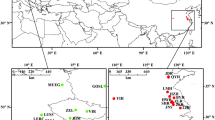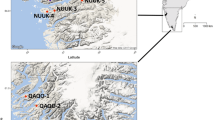Abstract
Using allozyme data based on four polymorphic enzymeloci, we present an analysis of geneticdifferentiation among eight Daphnia magnapopulations, separated by less than 100 m to more than500 km from each other. In spite of the large range ofgeographic distances, there was only a slight tendencyfor an increase in genetic differentiation withincreasing geographic distance between populations,and the relation was not significant. This was mainlydue to the fact that neighbouring populations werealready highly genetically differentiated. Our resultssuggest that in populations in which only a fewabundant clones are present after a period of strongclonal selection, among-populational geneticdifferentiation as revealed by allozyme markers isinflated as a result of stochasticity involving chanceassociations of alleles with specific abundantgenotypes. Indices quantifying genetic differentiationwere much higher among populations with a low clonaldiversity than among populations with a high clonaldiversity.
Similar content being viewed by others
References
Boileau, M. G., P. D. N. Hebert & S. S. Schwartz, 1992. Non-equilibrium gene frequency divergence: persistent founder effects in natural populations. J. evol. Biol. 5: 25–39.
Carvalho, G. R., 1994. Genetics of aquatic clonal organisms. In Beaumont, A. R. (ed.), Genetics and evolution of aquatic organisms. Chapman & Hall, London: 291–323.
Declerck, S., L. De Meester & J. M. Conde-Porcuna, this volume. The relevance of size efficiency to biomanipulation theory: a field test under hypertrophic conditions. Hydrobiologia.
De Meester, L., 1996. Local genetic differentiation and adaptation in freshwater zooplankton populations: patterns and processes. Ecoscience 3: 385–399.
Hebert, P. D. N., 1974. Enzyme variability in natural populations of Daphnia magnaI. Population structure in East Anglia. Evolution 28: 546–556.
Hebert, P. D. N., 1978. The population biology of Daphnia(Crustacea, Daphnidae). Biol. Rev. 53: 387–426.
Hebert, P. D. N., 1987. Genetics of Daphnia. In Peters, R. H. & R. De Bernardi (eds), Daphnia. Mem. Ist. ital. Idrobiol., Pallanza: 439–460.
Hebert, P. D. N. & M. J. Beaton, 1989. Methodologies for allozyme analysis using cellulose acetate electrophoresis. Helena Laboratories, Beaumont.
Hebert, P. D. N. & C. Moran, 1980. Enzyme variability in natural populations of Daphnia carinataKing. Heredity 45: 313–321.
Innes, D. J., 1991. Geographic patterns of genetic differentiation among sexual populations of Daphnia pulex. Can. J. Zool. 69: 995–1003.
Jacobs, J., 1990. Microevolution in predominantly clonal populations of pelagic Daphnia(Crustacea: Phyllopoda): selection, exchange, and sex. J. evol. Biol. 3: 257–282.
Korpelainen, H., 1984. Genic differentiation of Daphnia magna populations. Hereditas 101: 209–216.
Lynch, M., 1987. The consequences of fluctuating selection for isoenzyme polymorphisms in Daphnia. Genetics 115: 657–669.
Lynch, M. & K. Spitze, 1994. Evolutionary Genetics of Daphnia. In Real, L. A. (ed.), Ecological Genetics. Princeton Univ. Press, Princeton: 109–128.
Mort, M. A., 1991. Bridging the gap between ecology and genetics: the case of freshwater zooplankton. Trends Ecol. Evolution 6: 41–45.
Mort, M. A. & H. G. Wolf, 1986. The genetic structure of large-lake Daphniapopulations. Evolution 40: 756–766.
Nei, M., 1973. Analysis of gene diversity in subdivided populations. Proc. natn. Acad. Sci. USA 70: 3321–3323.
Peet, R. K., 1974. The measurement of species diversity. Ann. Rev. Ecol. Syst. 5: 285–307.
Proctor, V. W. & C. Malone, 1965. Further evidence of the passive dispersal of small aquatic organisms via the intestinal tract of birds. Ecology 46: 728–729.
Raymond, M. & F. Rousset, 1995. GENEPOP (version 1.2): population genetics software for exact tests and ecumenicism. J. Hered. 86: 248–249.
Rhomberg, L. R. & R. S. Singh, 1989. Evidence for a link between local and seasonal cycles in gene frequencies and latitudinal gene clines in a cyclic parthenogen. Genetica 78: 73–79.
Rice, W. R., 1989. Analysing tables of statistic tests. Evolution 43: 223–225.
Sokal, R. R. & F. J. Rohlf, 1995. Biometry, third edition. W. H. Freeman and Company, New York.
Swofford, D. L. & R. B. Selander, 1981. Biosys-1: a FORTRAN program for the comprehensive analysis for electrophoretic data in population genetics and systematics. J. Hered. 72: 281–283.
Weider, L. J., 1989. Population genetics of Polyphemus pediculus (Cladocera: Polyphemidae). Heredity 62: 1–10.
Wolf, H. G., 1988. Differences in the genetic structure of pond-dwelling and lake dwelling Daphnia. Verh. int. Ver. Limnol. 23: 2056–2059.
Author information
Authors and Affiliations
Rights and permissions
About this article
Cite this article
Vanoverbeke, J., De Meester, L. Among-populational genetic differentiation in the cyclical parthenogen Daphnia magna (Crustacea, Anomopoda) and its relation to geographic distance and clonal diversity. Hydrobiologia 360, 135–142 (1997). https://doi.org/10.1023/A:1003160903708
Issue Date:
DOI: https://doi.org/10.1023/A:1003160903708




